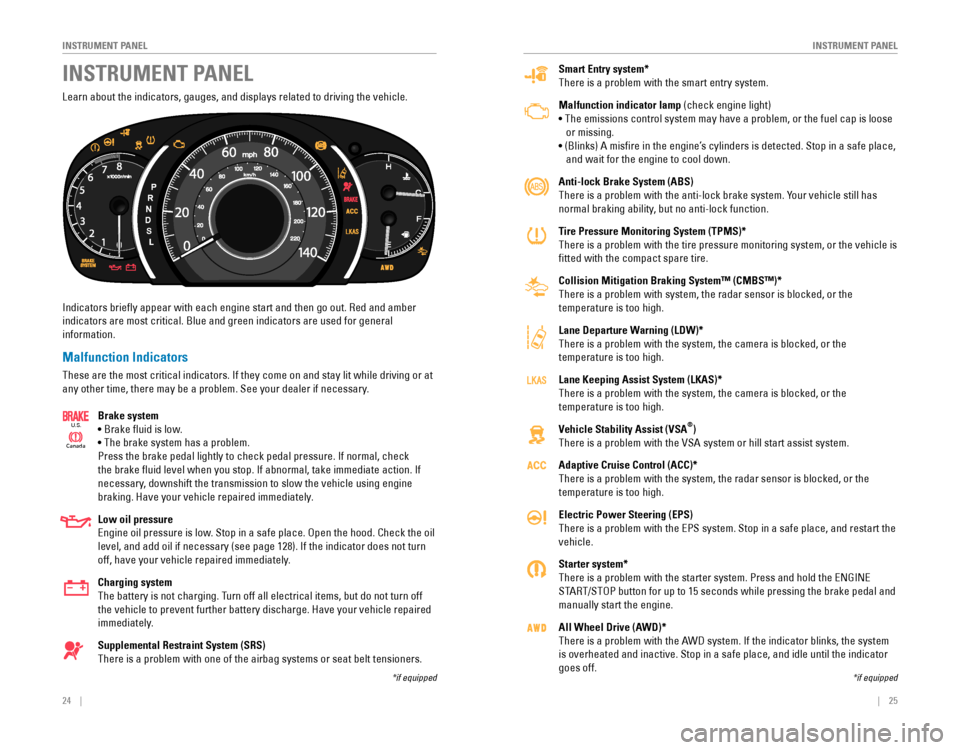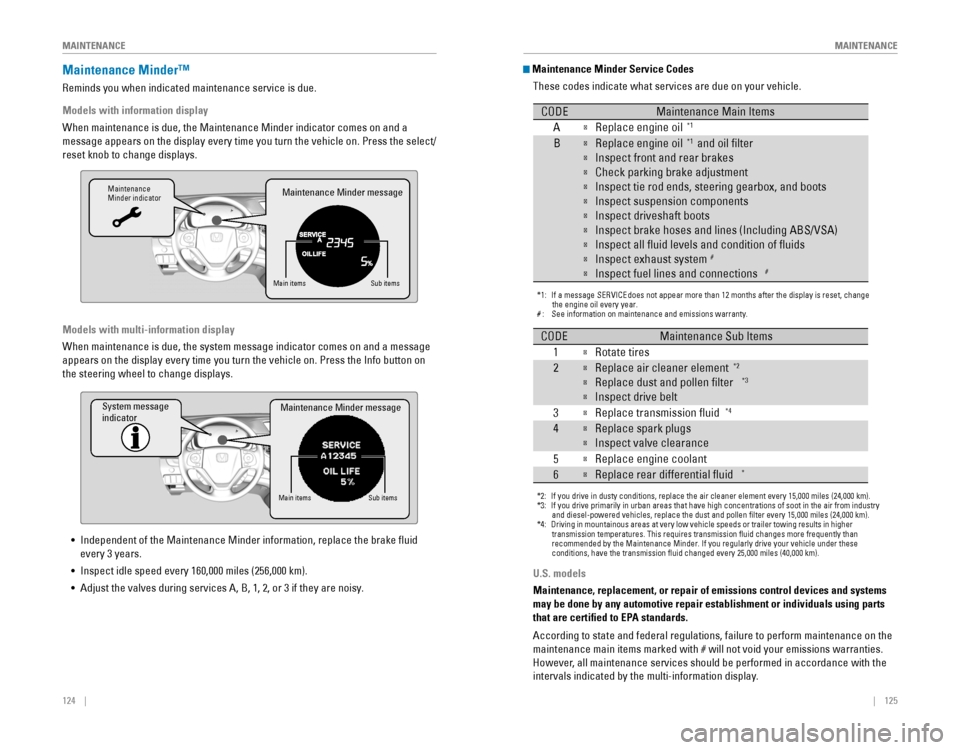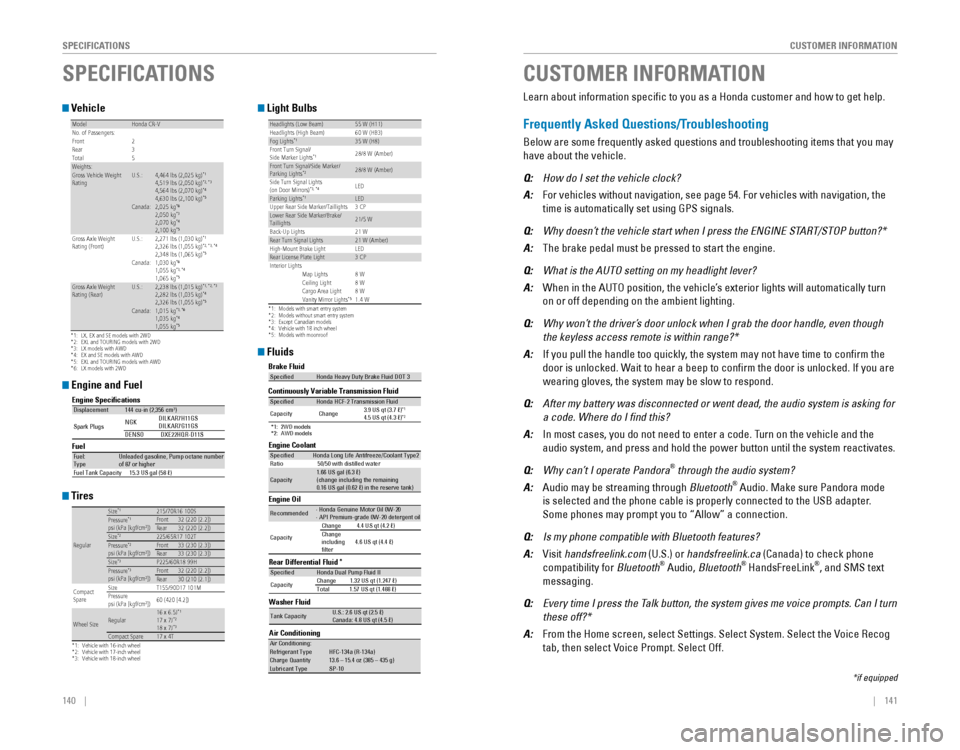check transmission fluid HONDA CR-V 2016 RM1, RM3, RM4 / 4.G Quick Guide
[x] Cancel search | Manufacturer: HONDA, Model Year: 2016, Model line: CR-V, Model: HONDA CR-V 2016 RM1, RM3, RM4 / 4.GPages: 80, PDF Size: 7.99 MB
Page 16 of 80

24 || 25
I
NSTRUMENT PANELINSTRUMENT PANEL
Smart Entry system*
There is a problem with the smart entry system.
Malfunction indicator lamp (check engine light)
• The emissions control system may have a problem, or the fuel cap is loose
or missing.
• (Blinks) A misfire in the engine’s cylinders is detected. Stop in a safe place,
and wait for the engine to cool down.
Anti-lock Brake System (ABS)
There is a problem with the anti-lock brake system. Your vehicle still has
normal braking ability, but no anti-lock function.
Tire Pressure Monitoring System (TPMS)*
There is a problem with the tire pressure monitoring system, or the vehicle is
fitted with the compact spare tire.
Collision Mitigation Braking System™ (CMBS™)*
There is a problem with system, the radar sensor is blocked, or the
temperature is too high.
Lane Departure Warning (LDW)*
There is a problem with the system, the camera is blocked, or the
temperature is too high.
Lane Keeping Assist System (LKAS)*
There is a problem with the system, the camera is blocked, or the
temperature is too high.
Vehicle Stability Assist (VSA
®)
There is a problem with the VSA system or hill start assist system.
Adaptive Cruise Control (ACC)*
There is a problem with the system, the radar sensor is blocked, or the
temperature is too high.
Electric Power Steering (EPS)
There is a problem with the EPS system. Stop in a safe place, and restart the
vehicle.
Starter system*
There is a problem with the starter system. Press and hold the ENGINE
START/STOP button for up to 15 seconds while pressing the brake pedal and
manually start the engine.
All Wheel Drive (AWD)*
There is a problem with the AWD system. If the indicator blinks, the system
is overheated and inactive. Stop in a safe place, and idle until the ind\
icator
goes off.
Learn about the indicators, gauges, and displays related to driving the vehicle.
Indicators briefly appear with each engine start and then go out. Red and amber
indicators are most critical. Blue and green indicators are used for general?
information.
Malfunction Indicators
These are the most critical indicators. If they come on and stay lit while driving or at
any other time, there may be a problem. See your dealer if necessary.
Brake system
• Brake fluid is low.
• The brake system has a problem.
Press the brake pedal lightly to check pedal pressure. If normal, check
the brake fluid level when you stop. If abnormal, take immediate action. If
necessary, downshift the transmission to slow the vehicle using engine
braking. Have your vehicle repaired immediately.
Low oil pressure
Engine oil pressure is low. Stop in a safe place. Open the hood. Check the oil
level, and add oil if necessary (see page 128). If the indicator does not turn
off, have your vehicle repaired immediately.
Charging system
The battery is not charging. Turn off all electrical items, but do not turn off
the vehicle to prevent further battery discharge. Have your vehicle repaired
immediately.
Supplemental Restraint System (SRS)
There is a problem with one of the airbag systems or seat belt tensioners.
Ca nada
U.S.
INSTRUMENT PANEL
*if equipped*if equipped
Page 66 of 80

124 || 125
MAINTENANCE
MAINTENANCE
Maintenance Minder™
Reminds you when indicated maintenance service is due.
Models with information display
When maintenance is due, the Maintenance Minder indicator comes on and a\
message appears on the display every time you turn the vehicle on. Press the select/
reset knob to change displays.
Maintenance
Minder indicator
Main itemsSub items
Maintenance Minder message
Models with multi-information display
When maintenance is due, the system message indicator comes on and a mes\
sage
appears on the display every time you turn the vehicle on. Press the Info button on
the steering wheel to change displays.
System message
indicator
Main itemsSub items
Maintenance Minder message
• Independent of the Maintenance Minder information, replace the brake fluid
every 3 years.
•
Inspect idle speed every 160,000 miles (256,000 km).
• Adjust the valves during services A, B, 1, 2, or 3 if they are noisy.
U.S. models
Maintenance, replacement, or repair of emissions control devices and sys\
tems
may be done by any automotive repair establishment or individuals using \
parts
that are certified to EPA standards.
According to state and federal regulations, failure to perform maintenan\
ce on the
maintenance main items marked with # will not void your emissions warranties.
However, all maintenance services should be performed in accordance with the
intervals indicated by the multi-information display.
Maintenance Minder Service Codes
These codes indicate what services are due on your vehicle.
*1: If a message SERVICE does not appear more than 12 months after the display is reset, change \
the engine oil every year.
#: See information on maintenance and emissions warranty.
CODEMaintenance Main Items
A
�Replace engine oi l*1
B�Replace engine oil*1 and oil �lter
�Inspect front and rear brakes
�Check parking brake adjustment
�Inspect tie rod ends, steering gearbox, and boots
�Inspect suspension components
�Inspect driveshaft boots
�Inspect brake hoses and lines (Including ABS/VSA)
�Inspect all �uid levels and condition of �uids
�Inspect exhaust system#
�Inspect fuel lines and connections#
*2: If you drive in dusty conditions, replace the air cleaner element every \
15,000 miles (24,000 km).
*3: If you drive primarily in urban areas that have high concentrations of s\
oot in the air from industry and diesel-powered vehicles, replace the dust and pollen �lter every \
15,000 miles (24,000 km).
*4: Driving in mountainous areas at very low vehicle speeds or trailer towing results in higher
transmission temperatures. This requires transmission �uid changes mo\
re frequently than
recommended by the Maintenance Minder. If you regularly drive your vehic\
le under these
conditions, have the transmission �uid changed every 25,000 miles (4\
0,000 km).
CODEMaintenance Sub Items
1
�Rotate tires
2�Replace air cleaner element*2
�Replace dust and pollen �lter*3
�Inspect drive belt
3
�Replace transmission �uid*4
4�Replace spark plug s
�Inspect valve clearance
5
�Replace engine coolant
6�Replace rear differential �uid*
Page 74 of 80

140 || 141
CUSTOMER INFORMATION
SPECIFICATIONS
Vehicle
*1:LX, EX and SE models with 2WD*2:EXL and TOURING models with 2WD*3:LX models with AWD*4:EX and SE models with AWD*5:EXL and TOURING models with AWD*6: LX models with 2WD
ModelHonda CR- VNo. of Passengers:
Front 2
Rear 3
Tota l5
Weights:Gross Vehicle Weight
Rating U.S.:4,464 lbs (2,025 kg )*14,519 lbs (2,050 kg)*2, *34,564 lbs (2,070 kg )*44,630 lbs (2,100 kg)*5Canada:2,025 kg*62,050 kg*32,070 kg*42,100 kg*5Gross Axle Weight
Rating (Front)U.S.:2,271 lbs (1,030 kg )*12,326 lbs (1,055 kg)*2, *3 , *42,348 lbs (1,065 kg )*5Canada:1,030 kg*61,055 kg*3, *41,065 kg*5Gross Axle Weight
Rating (Rear)U.S.:2,238 lbs (1,015 kg )*1, *2 , *32,282 lbs (1,035 kg )*42,326 lbs (1,055 kg)*5Canada:1,015 kg*3, *61,035 kg*41,055 kg*5
Engine and Fuel
Engine Speci�cation s
FuelDisplacemen t144 cu-in (2,356 cm3)
Spark Plugs NG
K DILKAR7H11GS
DILKAR7G11GS
DENSO DXE22HQR-D11 S
Fuel:
TypeUnleaded gasoline, Pump octane number of 87 or higher
Fuel Tank Capacity 15.3 US gal (58 �)
Tires
*1:Vehicle with 16-inch wheel*2:Vehicle with 17-inch wheel*3: Vehicle with 18-inch wheel
Regular
Size*1215/70R16 100 SPressure*1psi (k Pa [kgf/cm2])Front32 (220 [2.2])Rear32 (220 [2.2])Size*2225/65R17 102 TPressure*2psi (k Pa [kgf/cm2])Front33 (230 [2.3])Rear33 (230 [2.3])Size*3P225/60R18 99HPressure*3psi (k Pa [kgf/cm2])Front32 (220 [2.2])Rear30 (210 [2.1])
Compact
Spar e Size
T155/90D17 101M
Pr essure
psi (k Pa [kgf/cm
2])60 (420 [4.2])
Wheel SizeRegular16 x 6.5J*117 x 7J*218 x 7J*3Compact Spar
e17 x 4T
Light Bulbs
*1:Models with smart entry system*2:Models without smart entry system*3:Except Canadian models *4:Vehicle with 18 inch whee l*5: Models with moonroof
Headlights (Low Beam)55 W (H11 )Headlights (High Beam) 60 W (HB3)Fog Lights*135 W (H8)
Front Turn Signal/
Side Marker Light s
*128/8 W (Amber)
Front Turn Signal/Side Marker /
Parking Light s*228/8 W (Amber)
Side Turn Signal Lights
(on Door Mirrors )
*3, *4LED
Parking Light s*1LED
Upper Rear Side Marker/Taillight s3 CP
Lower Rear Side Marker/Brake/
Taillight s21/5 W
Back-Up Lights 21 W
Rear Turn Signal Light s21 W (Amber)
High- Mount Brak e LightL ED
Rear License Plate Light3 CP
In teri or Lights
Map Lights 8 W
Ceiling Light 8 W
Cargo Area Light 8 W
Vanity Mirror Lights
*51.4 W
Fluids
Washer Fluid
Tank Capacit yU.S.: 2.6 US qt (2.5 �)
Canada: 4.8 US qt (4.5 �)
Brake Fluid
Continuously Variable Transmission Fluid
*1: 2WD models
*2: AWD models
Rear Differential Fluid*
Speci�e dHonda Heavy Duty Brake Fluid DOT 3
Speci�edHonda HCF-2 Transmission Flui d
Capacity Change 3.9 US qt (3.7 �)*14.5 US qt (4.3 �)*2
Speci�e
dHonda Dual Pump Fluid II
Capacity Change
1.32 US qt (1.247 �)
Tota l1 .57 US qt (1.488 �)
Engine Oil
Engine Coolant
Recommende d· Honda Genuine Motor Oil 0W-2 0
· API Premium-grade 0W-20 detergent oi l
Capacity Change
4.4 US qt (4.2 �)
Change
including
�lter 4.6 US qt (4.4 �)
Speci�e
dHonda Long Life Anti freeze/Coolant Type 2
Ratio 50/50 with distilled wate r
Capacity1.66 US gal (6.3 �)
(change including the remaining
0.16 US gal (0.62 �) in the reserve tank )
Air ConditioningAir Conditioning:Refrigerant Type HFC-134a (R-134a)Charge Quantity13.6 – 15.4 oz (385 – 435 g)Lubricant TypeSP-10
SPECIFICATIONS
Learn about information specific to you as a Honda customer and how to get help.
Frequently Asked Questions/Troubleshooting
Below are some frequently asked questions and troubleshooting items that you may
have about the vehicle.
Q: How do I set the vehicle clock?
A: For vehicles without navigation, see page 54. For vehicles with navigation, the
time is automatically set using GPS signals.
Q: Why doesn’t the vehicle start when I press the ENGINE START/STOP button?*
A: The brake pedal must be pressed to start the engine.
Q: What is the AUTO setting on my headlight lever?
A: When in the AUTO position, the vehicle’s exterior lights will automatically turn
on or off depending on the ambient lighting.
Q: Why won’t the driver’s door unlock when I grab the door handle, even though
the keyless access remote is within range?*
A: If you pull the handle too quickly, the system may not have time to confirm the
door is unlocked. Wait to hear a beep to confirm the door is unlocked. If you are
wearing gloves, the system may be slow to respond.
Q: After my battery was disconnected or went dead, the audio system is asking for
a code. Where do I find this?
A: In most cases, you do not need to enter a code. Turn on the vehicle and the
audio system, and press and hold the power button until the system reactivates.
Q: Why can’t I operate Pandora® through the audio system?
A: Audio may be streaming through Bluetooth® Audio. Make sure Pandora mode
is selected and the phone cable is properly connected to the USB adapter.
Some phones may prompt you to “Allow” a connection.
Q: Is my phone compatible with Bluetooth features?
A: Visit handsfreelink.com (U.S.) or handsfreelink.ca (Canada) to check phone
compatibility for Bluetooth® Audio, Bluetooth® HandsFreeLink®, and SMS text
messaging.
Q: Every time I press the Talk button, the system gives me voice prompts. Can I turn
these off?*
A: From the Home screen, select Settings. Select System. Select the Voice Recog
tab, then select Voice Prompt. Select Off.
CUSTOMER INFORMATION
*if equipped